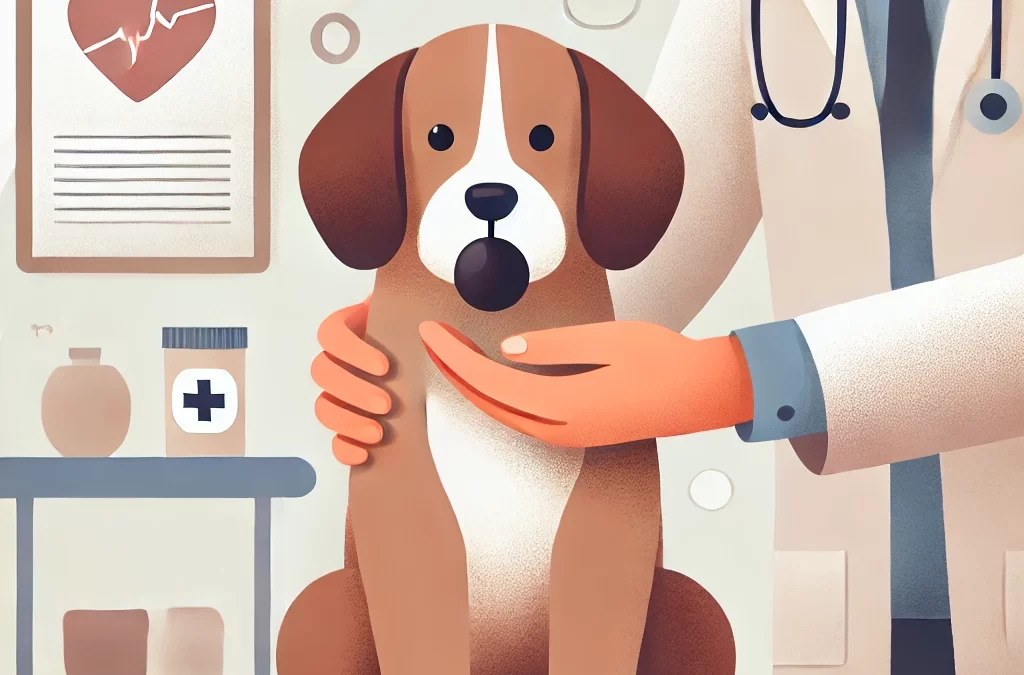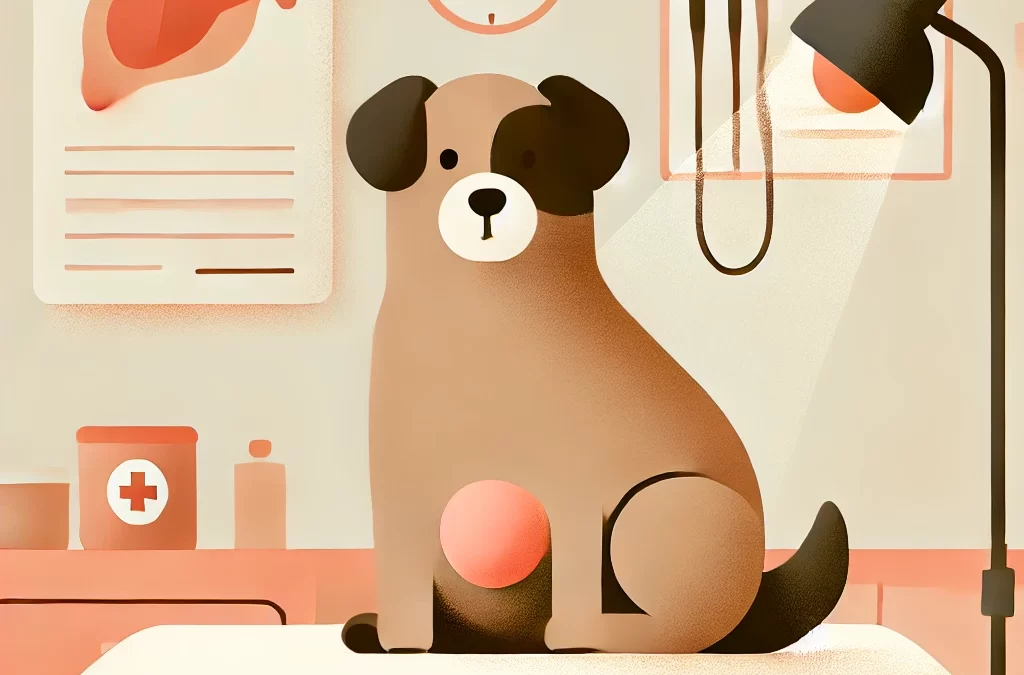
utworzone przez TCMVET | gru 20, 2024 | Rak i guzy u psów
Rak u psów od dawna jest przedmiotem troski właścicieli zwierząt domowych. Choć naturalne jest, że czujesz się przytłoczony, gdy stajesz w obliczu tej diagnozy, zrozumienie przyczyn może dać wgląd w profilaktykę i opiekę. Ten artykuł zagłębia się w potencjalne przyczyny raka u psów, rzucając światło na czynniki genetyczne, środowiskowe i związane ze stylem życia.
Predyspozycje genetyczne: cichy czynnik napędowy
Jednym z głównych powodów, dla których psy zapadają na raka, jest genetyka. Niektóre rasy są bardziej podatne na raka ze względu na dziedziczne cechy. Na przykład wiadomo, że golden retrievery, boksery i rottweilery mają większe prawdopodobieństwo zachorowania na raka, takiego jak chłoniak i kostniakomięsak. Ta genetyczna predyspozycja podkreśla znaczenie odpowiedzialnych praktyk hodowlanych w celu zminimalizowania ryzyka.
Toksyny środowiskowe: niewidzialne zagrożenia
Psy są często narażone na toksyny środowiskowe, a ich właściciele nie zdają sobie z tego sprawy. Pestycydy, herbicydy, bierne palenie, a nawet domowe środki czyszczące mogą przyczyniać się do rozwoju raka. Długotrwałe narażenie na te szkodliwe substancje może wywołać mutacje w komórkach, co ostatecznie prowadzi do wzrostu guza.
Dieta i otyłość: karmienie ryzyka
Zła dieta pozbawiona niezbędnych składników odżywczych lub bogata w przetworzoną żywność może osłabić układ odpornościowy psa, czyniąc go bardziej podatnym na raka. Otyłość dodatkowo pogarsza problem, tworząc środowisko zapalne w organizmie. Utrzymywanie zbilansowanej diety bogatej w przeciwutleniacze i unikanie przekarmiania może znacznie zmniejszyć ryzyko.
Starzenie się: czynnik naturalny
W miarę starzenia się psów ich komórki ulegają zużyciu, co zwiększa prawdopodobieństwo wystąpienia raka. Starsze psy często doświadczają spadku funkcji odpornościowej, co pozwala na niekontrolowaną proliferację nieprawidłowych komórek. To sprawia, że regularne kontrole weterynaryjne są niezbędne do wczesnego wykrycia i interwencji.
Nadmierne szczepienie i czynniki medyczne
Niektóre badania sugerują, że nadmierne szczepienia lub niepotrzebne procedury medyczne mogą mieć wpływ na zwiększenie ryzyka zachorowania na raka. Podczas gdy szczepionki są kluczowe dla zapobiegania chorobom, nadmierne lub źle zaplanowane szczepienia mogą obciążać układ odpornościowy psa. Zawsze skonsultuj się z zaufanym lekarzem weterynarii, aby dostosować plan szczepień do potrzeb swojego psa.
Ekspozycja na słońce i uszkodzenia spowodowane promieniowaniem UV
W przypadku psów o jasnym futrze lub cienkiej sierści nadmierna ekspozycja na słońce może prowadzić do raka skóry, szczególnie w miejscach o słabej pigmentacji. Ochrona psa bezpiecznym dla zwierząt filtrem przeciwsłonecznym lub ograniczenie aktywności na zewnątrz w godzinach szczytu słonecznego może pomóc.
Jak zminimalizować ryzyko
- Zbilansowane odżywianie: Zapewnij wysokiej jakości dietę dostosowaną do wieku, rasy i poziomu aktywności Twojego psa. Dołącz naturalne źródła przeciwutleniaczy, takie jak borówki i marchewki.
- Ogranicz narażenie na toksyny: Stosuj środki czyszczące bezpieczne dla zwierząt i nie narażaj psa na działanie pestycydów lub dymu tytoniowego.
- Regularne ćwiczenia: Utrzymuj zdrową masę ciała dzięki regularnej aktywności fizycznej.
- Rutynowe wizyty u weterynarza: Zaplanuj coroczne badania kontrolne i przesiewowe, aby wcześnie wykryć potencjalne problemy zdrowotne.
- Indywidualne plany szczepień: Współpracuj z lekarzem weterynarii, aby opracować harmonogram szczepień dostosowany do trybu życia i stanu zdrowia Twojego psa.
Zamykające myśli
Rak u psów to złożona choroba, na którą wpływa mieszanka czynników genetycznych, środowiskowych i związanych ze stylem życia. Chociaż nie da się wyeliminować wszystkich ryzyk, podejmowanie proaktywnych działań może znacznie zmniejszyć prawdopodobieństwo zachorowania na raka. Dzięki informowaniu i uważności właściciele zwierząt domowych mogą zapewnić swoim futrzanym towarzyszom najlepszą możliwą opiekę i jakość życia.

utworzone przez TCMVET | gru 18, 2024 | Rak i guzy u psów
Chłoniak jest jednym z najczęstszych nowotworów u psów i chociaż często można go leczyć za pomocą takich metod jak chemioterapia, nadchodzi moment, w którym choroba może postępować pomimo interwencji. Rozpoznanie oznak, że Twój pies zbliża się do końca swojej drogi, może pomóc Ci zapewnić mu komfort i podejmować świadome decyzje dotyczące jego opieki. Oto przewodnik, który pomoże Ci zrozumieć oznaki chłoniaka w późnym stadium i jak wspierać ukochanego zwierzaka w tym trudnym czasie.
Zrozumienie chłoniaka psów
Chłoniak atakuje układ limfatyczny, który jest częścią układu odpornościowego. Może objawiać się w różnych częściach ciała, w tym węzłach chłonnych, śledzionie, wątrobie i przewodzie pokarmowym. Postęp choroby jest różny, ale w miarę jej postępu organizm staje się coraz bardziej zagrożony, co prowadzi do znaczących zmian fizycznych i behawioralnych.
Objawy, że Twój pies może umierać na chłoniaka
Silne zmęczenie i letarg
Psy z zaawansowanym chłoniakiem często wykazują skrajne zmęczenie. Twój kiedyś aktywny pupil może spędzać większość dnia śpiąc lub leżąc, wykazując niewielkie zainteresowanie czynnościami, które kiedyś sprawiały mu przyjemność.
Trudności w oddychaniu
Chłoniak w klatce piersiowej może powodować gromadzenie się płynu wokół płuc, co utrudnia oddychanie psu. Objawy obejmują szybki oddech, płytki oddech lub wysiłek.
Utrata apetytu
Umierający pies może odmawiać jedzenia lub picia, co wskazuje, że jego ciało się wyłącza. Nawet jego ulubione smakołyki mogą pozostać nietknięte.
Utrata wagi i zanik mięśni
W miarę postępu choroby widoczna jest znaczna utrata wagi i zanik mięśni (kacheksja). Żebra i kręgosłup psa mogą stać się bardziej widoczne.
Obrzęk węzłów chłonnych
Choć powiększone węzły chłonne są charakterystycznym objawem chłoniaka, ich wielkość może znacznie wzrosnąć w miarę jak choroba zbliża się do końcowego stadium.
Wymioty i biegunka
Jeśli chłoniak atakuje przewód pokarmowy, u psa mogą wystąpić przewlekłe wymioty, biegunka lub jedno i drugie. Objawy te mogą prowadzić do odwodnienia i dalszego osłabienia organizmu.
Ból i dyskomfort
Twój pies może wykazywać oznaki bólu, takie jak skomlenie, trudności z położeniem się lub niechęć do poruszania się. Ból może wynikać z uszkodzenia narządów, stanu zapalnego lub ucisku spowodowanego przez guzy.
Zmiany w zachowaniu
Psy często stają się wycofane, gdy zbliżają się do końca życia. Mogą unikać interakcji, szukać samotności lub wydawać się zdezorientowane.
Jak wspierać psa w tym czasie
Skonsultuj się z lekarzem weterynarii, aby upewnić się, że Twój pies otrzymuje odpowiednie leczenie bólu i opiekę paliatywną. Leki takie jak leki przeciwwymiotne, środki pobudzające apetyt i środki przeciwbólowe mogą poprawić komfort Twojego psa.
Stwórz ciche i spokojne otoczenie, w którym Twój pies może odpocząć bez przeszkód. Zapewnij miękkie posłanie i trzymaj jego ulubione przedmioty w pobliżu.
Podawaj małe ilości łatwo strawnego jedzenia, jeśli pies chce jeść. Nawodnienie jest również ważne, ale nie zmuszaj go do picia.
Spędzaj jakościowy czas ze swoim pupilem, okazując mu delikatne uczucie i zapewniając go. Obecność może zapewnić ogromny komfort zarówno tobie, jak i twojemu psu.
Rozważ humanitarną eutanazję, jeśli jakość życia Twojego psa znacznie się pogorszy. Choć jest to trudna decyzja, może być to współczujący sposób na złagodzenie jego cierpienia.
Wnioski
Rozpoznanie oznak, że Twój pies może umierać z powodu chłoniaka, pozwala Ci skupić się na jego komforcie i samopoczuciu. Podróż każdego psa jest wyjątkowa, a Twoja miłość i opieka w tym czasie będą miały znaczący wpływ na jego ostatnie dni.

utworzone przez TCMVET | gru 18, 2024 | Rak i guzy u psów
Wprowadzenie: Cichy wróg w leczeniu raka u psów
Wyniszczenie nowotworowe, złożony zespół metaboliczny charakteryzujący się znaczną utratą wagi i zanikiem mięśni, jest cichym, ale śmiertelnym schorzeniem dotykającym wiele psów z rakiem. Często przyćmione przez chorobę podstawową, wyniszczenie znacząco wpływa na jakość życia, reakcję na leczenie i ogólne przeżycie dotkniętych chorobą zwierząt domowych. Zrozumienie i zajęcie się tym schorzeniem ma kluczowe znaczenie dla holistycznej opieki onkologicznej u psów.
What is Cancer Cachexia?
Wyniszczenie nowotworowe to coś więcej niż tylko utrata wagi. To wieloczynnikowy stan spowodowany współgraniem ogólnoustrojowego stanu zapalnego, dysregulacji metabolicznej i zapotrzebowania metabolicznego guza. Kluczowe cechy obejmują:
- Utrata masy mięśniowej:W przeciwieństwie do zwykłego głodowania, wyniszczenie organizmu prowadzi do utraty masy mięśniowej, której nie można odwrócić poprzez zwiększenie spożycia kalorii.
- Appetite Changes:U psów może wystąpić zmniejszone zainteresowanie jedzeniem (anoreksja) lub zmienione preferencje smakowe.
- Zapalenie układowe:Zapalenie wywołane przez guz zaostrza zaburzenia metaboliczne, jeszcze bardziej pogarszając stan zdrowia.
Dlaczego u psów występuje wyniszczenie nowotworowe?
Dokładne mechanizmy wyniszczenia nowotworowego są złożone i różnią się w zależności od rodzaju i stadium nowotworu. Czynniki przyczyniające się do tego stanu obejmują:
- Tumor Metabolism:Niektóre nowotwory wydzielają substancje, które zakłócają normalne procesy metaboliczne, powodując rozpad mięśni i tłuszczu.
- Cytokiny i hormony:Wzrost poziomu cytokin prozapalnych (np. TNF-alfa) i zaburzenia równowagi hormonalnej odgrywają kluczową rolę w powodowaniu wyniszczenia organizmu.
- Niedobory żywieniowe:Zmniejszone spożycie pokarmu i zaburzone wchłanianie składników odżywczych pogarszają stan psa.
Rozpoznawanie wyniszczenia nowotworowego u psów
Wczesne wykrycie jest kluczowe w leczeniu wyniszczenia nowotworowego. Zwróć uwagę na te objawy:
- Niewyjaśniona utrata wagi pomimo odpowiedniego spożycia pokarmu
- Zanik mięśni, szczególnie w okolicach kręgosłupa i tylnych nóg
- Zmęczenie i obniżony poziom aktywności
- Zmiany apetytu lub zachowania żywieniowego
Innowacyjne strategie zarządzania
Chociaż nie ma uniwersalnego rozwiązania, multimodalne podejście może pomóc w leczeniu wyniszczenia u psów. Oto kilka pojawiających się strategii:
- Spersonalizowane wsparcie żywieniowe:Dieta bogata w wysokiej jakości białka, kwasy tłuszczowe omega-3 i konkretne aminokwasy, takie jak glutamina, może pomóc w zachowaniu masy mięśniowej.
- Appetite Stimulants:Leki takie jak mirtazapina lub kapromorelina mogą poprawić apetyt i ilość przyjmowanego pokarmu.
- Anti-Inflammatory Therapies:Suplementy zawierające kwasy omega-3 i leki oddziałujące na szlaki zapalne mogą zmniejszać aktywność cytokin.
- Modulatory metaboliczneBadania nad lekami takimi jak anamorelina i mimetyki greliny dają obiecujące rezultaty w odwróceniu zaniku mięśni.
Rola medycyny integracyjnej
Naturalne terapie, takie jak Tradycyjna Medycyna Chińska (TCM), wykazały potencjał łagodzenia objawów. Zioła takie jak astragalus i żeń-szeń mogą wspierać funkcje odpornościowe i poziom energii, podczas gdy akupunktura może poprawić apetyt i zmniejszyć stan zapalny.
Spojrzenie w przyszłość: potrzeba dalszych badań
Pomimo postępu, wyniszczenie nowotworowe pozostaje niedostatecznie zbadane w medycynie weterynaryjnej. Współpraca między weterynarzami, badaczami i właścicielami zwierząt domowych jest niezbędna do opracowania nowych terapii i poprawy wyników leczenia dotkniętych chorobą psów.
Wnioski: Nadzieja poprzez innowację
Chociaż wyniszczenie nowotworowe stanowi poważne wyzwanie, postęp w zrozumieniu i leczeniu tego stanu daje nadzieję. Przyjmując holistyczne i proaktywne podejście, możemy poprawić jakość życia psów walczących z rakiem i pomóc im cieszyć się złotymi latami z godnością i komfortem.

utworzone przez TCMVET | gru 16, 2024 | Rak i guzy u psów
Czerniak złośliwy jamy ustnej (OMM) u psów to podstępny przeciwnik. Znany ze swojej agresywnej natury i szybkiego rozprzestrzeniania się, jest diagnozą, która wzbudza strach w sercach właścicieli zwierząt domowych. Ale OMM to coś więcej niż tylko stan chorobowy — to wezwanie do działania dla właścicieli zwierząt domowych, aby przyjęli czujność, innowację i holistyczną opiekę. Przyjrzyjmy się temu trudnemu tematowi z nowej perspektywy, badając zarówno naukę, jak i nadzieję.
Czym jest czerniak złośliwy jamy ustnej?
Czerniak złośliwy jamy ustnej to rodzaj raka, który powstaje w melanocytach — komórkach odpowiedzialnych za produkcję pigmentu w skórze i błonach śluzowych. Chociaż najczęściej pojawia się w jamie ustnej, ten rak nie zatrzymuje się na tym. Jest znany ze swojej zdolności do naciekania pobliskich tkanek i przerzutowania do odległych narządów, takich jak płuca i węzły chłonne.
Ten stan jest najbardziej rozpowszechniony u psów w średnim i starszym wieku, szczególnie ras o ciemno pigmentowanych dziąsłach, takich jak Cocker Spaniele, Chow Chow i Scottish Terriery. Pomimo ponurej reputacji, zrozumienie objawów OMM i opcji leczenia może pomóc właścicielom podejmować świadome decyzje.
Rozpoznawanie znaków
Złośliwy czerniak jamy ustnej często pozostaje niezauważony, dopóki nie osiągnie zaawansowanego stadium, co sprawia, że regularne kontrole jamy ustnej są kluczowe. Typowe objawy obejmują:
- Ciemna lub nieregularna masa w jamie ustnej, dziąsłach lub wargach.
- Krwawienie, nieświeży oddech lub ślinienie się.
- Trudności w jedzeniu, żuciu lub połykaniu.
- Obrzęk twarzy lub powiększone węzły chłonne.
Jeśli zauważysz którykolwiek z tych objawów, natychmiast skonsultuj się z lekarzem weterynarii. Wczesne wykrycie może znacząco wpłynąć na wyniki.
Poza tradycyjnymi metodami leczenia: wdrażanie innowacji
Konwencjonalne metody leczenia OMM obejmują operację, radioterapię i chemioterapię. Choć w wielu przypadkach są skuteczne, opcje te nie zawsze są dostępne lub niedrogie. Oto kilka innowacyjnych i integracyjnych podejść, które zyskują uwagę:
- Szczepionki immunoterapeutyczne: Przełomowe w onkologii szczepionki specyficzne dla OMM, takie jak szczepionka przeciwko czerniakowi u psów (ONCEPT®), stymulują układ odpornościowy psa do walki z komórkami nowotworowymi. Ta najnowocześniejsza metoda leczenia okazała się obiecująca w wydłużaniu czasu przeżycia.
- Terapia fotodynamiczna (PDT): Ta technika wykorzystuje leki aktywowane światłem, aby selektywnie niszczyć komórki nowotworowe, oszczędzając otaczającą zdrową tkankę. Jest to mniej inwazyjna opcja w niektórych przypadkach.
- Suplementy holistyczne: Naturalne suplementy, takie jak kurkumina (znajdująca się w kurkumie), grzyby lecznicze i kwasy tłuszczowe omega-3, są badane pod kątem ich właściwości przeciwzapalnych i wzmacniających odporność. Zawsze skonsultuj się z weterynarzem przed włączeniem suplementów.
Rola diety w rekonwalescencji
Diagnoza raka wymaga zmiany strategii dietetycznych. Psy walczące z OMM korzystają z diety dostosowanej do ich potrzeb metabolicznych. Skup się na:
- Wysokiej jakości białka: Chude mięso i ryby dla utrzymania masy mięśniowej.
- Zdrowe tłuszcze: Kwasy tłuszczowe omega-3 zwalczają stany zapalne i wspomagają ogólny stan zdrowia.
- Opcje niskowęglowodanowe: Komórki nowotworowe żywią się cukrem; ograniczenie spożycia węglowodanów może pomóc spowolnić ich wzrost.
Domowe posiłki zatwierdzone przez weterynarza mogą być świetnym sposobem na zapewnienie psu optymalnego odżywiania.
Wsparcie emocjonalne i praktyczne dla właścicieli zwierząt domowych
Opieka nad psem z OMM jest tak samo wymagająca emocjonalnie, jak i trudna. Oto, jak poruszać się po tej podróży:
- Stwórz codzienną rutynę pielęgnacyjną: Wprowadzenie konsekwencji może pomóc w zmniejszeniu stresu zarówno u Ciebie, jak i u Twojego psa.
- Szukaj wsparcia społeczności: Fora internetowe i lokalne grupy wsparcia dla właścicieli zwierząt chorujących na raka u psów mogą być źródłem pocieszenia i cennych informacji.
- Poznaj opcje opieki paliatywnej: Jeśli leczenie radykalne nie wchodzi w grę, należy skupić się na łagodzeniu bólu i poprawie jakości życia psa.
Promyk nadziei
Podczas gdy czerniak złośliwy jamy ustnej u psów jest groźnym wrogiem, postęp w medycynie weterynaryjnej i opiece integracyjnej zmienia narrację. Wczesne wykrywanie, innowacyjne metody leczenia i skupienie się na holistycznym samopoczuciu dają właścicielom zwierząt domowych możliwość walki z tą chorobą.
Diagnoza Twojego psa nie definiuje podróży — to rozdział w historii jego odporności, miłości i więzi, którą dzielicie. Nadal zadawaj pytania, szukaj rozwiązań i ciesz się każdą chwilą.

utworzone przez TCMVET | gru 16, 2024 | Rak i guzy u psów
Odkrycie guza na brzuchu psa może być alarmujące. Jako właściciele zwierząt domowych, naszym pierwszym instynktem jest często obawa — ale nie wszystkie guzy są niebezpieczne. W rzeczywistości wiele z nich jest łagodnych i można sobie z nimi poradzić przy odpowiedniej pielęgnacji. Aby pomóc Ci poradzić sobie z tą sytuacją, przedstawiamy świeżą perspektywę zrozumienia, identyfikacji i leczenia guzów żołądka u psów.
Czym dokładnie jest guzek w żołądku?
Guzek żołądka u psów odnosi się do każdej nieprawidłowej masy lub obrzęku w okolicy brzucha. Mogą one różnić się rozmiarem, kształtem i fakturą — niektóre są miękkie i ruchome, podczas gdy inne mogą być twarde lub przyczepione do tkanek podskórnych.
Kluczem do radzenia sobie z takimi grudkami jest obserwacja i terminowe działanie. Zanim wyciągniemy wnioski, przyjrzyjmy się najczęstszym przyczynom powstawania tych narośli.
Najczęstsze przyczyny powstawania guzów w żołądku
- Lipoma (guzy tłuszczowe): Są to łagodne, miękkie i wolno rosnące guzy powszechnie występujące u starszych psów. Lipomas rzadko stanowią zagrożenie dla zdrowia i zwykle są raczej problemem kosmetycznym.
- Krwiaki lub ropnie: Jeśli Twój pies niedawno doznał urazu, guz może być krwiakiem (nagromadzeniem krwi pod skórą) lub ropniem spowodowanym infekcją. Często są ciepłe i wrażliwe na dotyk.
- Przepukliny: Przepukliny powstają, gdy tkanki wewnętrzne lub narządy przeciskają się przez słabe miejsce w ścianie brzucha. Mogą być miękkie i zmniejszać się po delikatnym naciśnięciu.
- Nowotwory złośliwe: Niestety, niektóre guzy są nowotworowe. Guzy komórek tucznych, mięsaki tkanek miękkich i inne nowotwory złośliwe często wymagają natychmiastowej interwencji i leczenia weterynaryjnego.
- Cysty lub narośla gruczołów łojowych: Są to często wypełnione płynem worki lub zatkane gruczoły, które mogą pojawić się na żołądku psa. Są one zazwyczaj nieszkodliwe, ale mogą wymagać drenażu lub drobnej operacji, jeśli staną się zbyt duże.
Znaki wymagające natychmiastowej uwagi
Choć nie wszystkie guzki w żołądku powinny budzić niepokój, pewne objawy wskazują na konieczność pilnej wizyty u weterynarza:
- Guz szybko rośnie.
- Pies sprawia wrażenie, jakby odczuwał ból, gdy ktoś dotyka tego obszaru.
- Guz jest twardy, nieruchomy lub ma nieregularny kształt.
- W okolicy występuje zaczerwienienie, obrzęk lub wydzielina.
- U Twojego psa występują objawy letargu, utraty apetytu lub innych problemów ogólnoustrojowych.
Co zrobić, jeśli odkryjesz guzek
- Monitoruj guzek: Śledź jego rozmiar, teksturę i zachowanie. Robienie zdjęć co kilka dni może pomóc Ci zauważyć wszelkie zmiany.
- Zaplanuj wizytę u weterynarza: Lekarz weterynarii może przeprowadzić badanie fizykalne i zalecić testy diagnostyczne, takie jak biopsja aspiracyjna cienkoigłowa, biopsja lub badanie USG, w celu określenia charakteru guza.
- Rozważ opcje leczenia: W zależności od diagnozy weterynarz może zasugerować obserwację, leki, operację lub inne terapie. W przypadku łagodnych narośli, takich jak tłuszczaki, leczenie może nie być konieczne, chyba że guzek powoduje dyskomfort.
- Poznaj naturalne środki lecznicze (za zgodą weterynarza): W przypadku niezłośliwych narośli niektórzy właściciele zwierząt domowych sięgają po naturalne suplementy, takie jak kurkuma, kwasy tłuszczowe omega-3 lub ziołowe kuracje, które wspomagają ogólne zdrowie układu odpornościowego. Zawsze skonsultuj się z lekarzem weterynarii przed wprowadzeniem jakiegokolwiek nowego suplementu.
Porady dotyczące profilaktyki dla zdrowego psa
- Regularne kontrole: Wczesne wykrycie jest kluczowe dla skutecznego leczenia guzów. Regularne wizyty u weterynarza zapewniają, że wszelkie zmiany zostaną szybko zaadresowane.
- Zbilansowana dieta: Dieta bogata w składniki odżywcze może wspierać ogólny stan zdrowia i odporność Twojego psa.
- Utrzymaj zdrową wagę: Otyłość zwiększa ryzyko wystąpienia guzów tłuszczowych i innych problemów zdrowotnych. Utrzymuj psa w aktywności i przy idealnej wadze.
- Pielęgnacja skóry: Regularne czesanie oraz kontrola sierści i skóry psa mogą pomóc we wczesnym wykryciu nieprawidłowości.
Słowo pocieszenia
Nie każdy guz zagraża życiu, a postęp medycyny weterynaryjnej sprawił, że diagnoza i leczenie są skuteczniejsze niż kiedykolwiek. Pozostając uważnym i proaktywnym, możesz zapewnić, że Twój pies będzie szczęśliwy i zdrowy.
Jeśli zauważysz guzek w żołądku, weź głęboki oddech i skontaktuj się z weterynarzem. Razem znajdziecie najlepszą drogę naprzód dla swojego futrzanego towarzysza.
Tagi: guz w żołądku u psa, przyczyny powstawania guzów u psów, leczenie guzów u psów, opieka zdrowotna nad psami, łagodne guzy u psów, naturalne środki zaradcze dla psów





